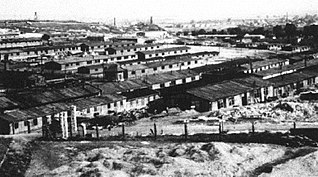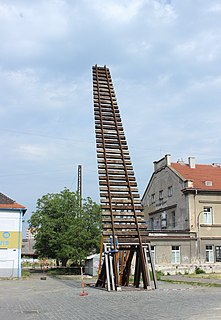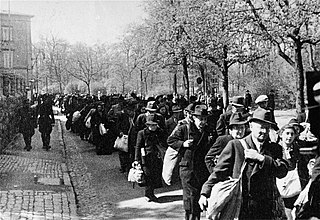
The Final Solution or the Final Solution to the Jewish Question was a Nazi plan for the genocide of Jews during World War II. The "Final Solution to the Jewish question" was the official code name for the murder of all Jews within reach, which was not restricted to the European continent. This policy of deliberate and systematic genocide starting across German-occupied Europe was formulated in procedural and geopolitical terms by Nazi leadership in January 1942 at the Wannsee Conference held near Berlin, and culminated in the Holocaust, which saw the murder of 90% of Polish Jews, and two-thirds of the Jewish population of Europe.

Nazi Germany used six extermination camps, also called death camps (Todeslager), or killing centers (Tötungszentren), in Central Europe during World War II to systematically murder over 2.7 million people – mostly Jews – in the Holocaust. The victims of death camps were primarily murdered by gassing, either in permanent installations constructed for this specific purpose, or by means of gas vans. The six extermination camps were Chełmno, Belzec, Sobibor, Treblinka, Majdanek and Auschwitz-Birkenau. Auschwitz and Majdanek death camps also used extermination through labour in order to kill their prisoners.

The ghetto uprisings during World War II were a series of armed revolts against the regime of Nazi Germany between 1941 and 1943 in the newly established Jewish ghettos across Nazi-occupied Europe. Following the German and Soviet invasion of Poland in September 1939, Polish Jews were targeted from the outset. Within months inside occupied Poland, the Germans created hundreds of ghettos in which they forced the Jews to live. The new ghettos were part of the German official policy of removing Jews from public life with the aim of economic exploitation. The combination of excess numbers of inmates, unsanitary conditions and lack of food resulted in a high death rate among them. In most cities the Jewish underground resistance movements developed almost instantly, although ghettoization had severely limited their access to resources.

The German camps in occupied Poland during World War II were built by the Nazis between 1939 and 1945 throughout the territory of the Polish Republic, both in the areas annexed in 1939, and in the General Government formed by Nazi Germany in the central part of the country (see map). After the 1941 German attack on the Soviet Union, a much greater system of camps was established, including the world's only industrial extermination camps constructed specifically to carry out the "Final Solution to the Jewish Question".

Gross-Rosen was a network of Nazi concentration camps built and operated by Nazi Germany during World War II. The main camp was located in the German village of Gross-Rosen, now the modern-day Rogoźnica in Lower Silesian Voivodeship, Poland; directly on the rail-line between the towns of Jawor (Jauer) and Strzegom (Striegau). Its prisoners were mostly Jews, Poles and Soviet citizens.

Operation Harvest Festival was the murder of up to 43,000 Jews at the Majdanek, Poniatowa and Trawniki concentration camps by the SS, the Order Police battalions, and the Ukrainian Sonderdienst on 3–4 November 1943.
Marcinkonys or Marcinkańce Ghetto was a small Jewish ghetto established during the Holocaust in Marcinkonys. It existed from around November 1941 to November 1942 and housed 300 to 400 Jews.

Jewish resistance under Nazi rule took various forms of organized underground activities conducted against German occupation regimes in Europe by Jews during World War II. According to historian Yehuda Bauer, Jewish resistance was defined as actions that were taken against all laws and actions acted by Germans. The term is particularly connected with the Holocaust and includes a multitude of different social responses by those oppressed, as well as both passive and armed resistance conducted by Jews themselves.

The Holocaust in Poland was part of the European-wide Holocaust organized by Nazi Germany and took place in German-occupied Poland. During the genocide, three million Polish Jews were murdered, half of all Jews murdered during the Holocaust.

The Holocaust, also known as the Shoah, was the genocide of European Jews during World War II. Between 1941 and 1945, Nazi Germany and its collaborators systematically murdered around six million Jews across German-occupied Europe, around two-thirds of Europe's Jewish population. The murders were carried out in pogroms and mass shootings; by a policy of extermination through labor in concentration camps; and in gas chambers and gas vans in German extermination camps, chiefly Auschwitz-Birkenau, Bełżec, Chełmno, Majdanek, Sobibór, and Treblinka in occupied Poland.

The Sosnowiec Ghetto was a World War II ghetto set up by Nazi German authorities for Polish Jews in the Środula district of Sosnowiec in the Province of Upper Silesia. During the Holocaust in occupied Poland, most inmates, estimated at over 35,000 Jewish men, women and children were deported to Auschwitz death camp aboard Holocaust trains following roundups lasting from June until August 1943. The Ghetto was liquidated during an uprising, a final act of defiance of its Underground Jewish Combat Organization (ŻOB) made up of youth. Most of the Jewish fighters perished.

The Holocaust in the Protectorate of Bohemia and Moravia, a portion of the Czech lands partially annexed into Nazi Germany, resulted in the deportation, dispossession, and death of 80,000 Jews, most of the prewar population.

The Holocaust in the Sudetenland resulted in the flight, dispossession, deportation and ultimately death of many of the 24,505 Jews living in the Reichsgau Sudetenland, a Nazi German administrative region established from former Czechoslovak territory annexed after the October 1938 Munich Agreement. Due to harassment and violence, including during Kristallnacht, ninety percent of the Jews had already left the Sudetenland by mid-1939. The remaining Jews were subject to property confiscation and eventually deportation. During the later years of the war, tens of thousands of Jews and non-Jews were forced laborers in a network of concentration camps in the Sudetenland.
Wolf Gruner is a German academic who has been the Founding Director of the Center for Advanced Genocide Research at the University of Southern California Shoah Foundation since 2014. He currently holds the Shapell-Guerin Chair in Jewish Studies and is also Professor of History at USC. Since 2017, he is a member of the Academic Advisory Committee of the Center for Advanced Holocaust Studies at the United States Holocaust Memorial Museum.
Organization Schmelt was a Nazi SS organization that ran a system of forced-labor camps with mostly Jewish prisoners. It originated in East Upper Silesia, but spread to the Sudetenland and other areas. Many of its camps were later absorbed into concentration camp systems such as Auschwitz and Gross-Rosen.

The question of how much Germans and other Europeans knew about the Holocaust while it was ongoing continues to be debated by historians. With regards to Nazi Germany, some historians argue that it was an open secret amongst the population whilst others highlight a possibility that the German population were genuinely unaware of the Final Solution. Peter Longerich argues that the Holocaust was an "open secret" by early 1943, but some authors place it even earlier. However, after the war, many Germans claimed that they were ignorant of the crimes perpetrated by the Nazi regime, often using the stereotypical phrase "davon haben wir nichts gewusst".
Jews who were married to non-Jews had a greater chance of surviving the Holocaust. In Germany, Jews in "privileged mixed marriages" were exempt from some anti-Jewish laws. All intermarried Jews in Greater Germany were generally exempted from deportation during the Holocaust until early 1945, which enabled 90 percent to survive. However, they faced strong pressure from Nazi authorities to divorce, which would end the protection for the Jewish partner. A famous event is the 1943 Rosenstrasse protest, in which non-Jewish women protested in Berlin after their Jewish husbands were arrested. It is unclear whether this action prevented the deportation of their husbands.












